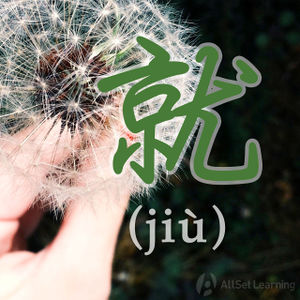Difference between revisions of "Expressing "small quantity" with "jiu""
| Line 26: | Line 26: | ||
<div class="jiegou"> | <div class="jiegou"> | ||
| − | Subj.+ 就 + Verb +a few things or persons | + | Subj. + 就 + Verb + a few things or persons |
</div> | </div> | ||
Revision as of 08:22, 24 October 2016
-
Level
-
Similar to
-
Used for
-
Keywords
就 (jiù) is often translated simply as "just" or "only," but there are some nuances to how it is used.
Contents
Structure with 就 meaning "only have"
就(jiù)can mean "only have".
Subj. + 就 + a few things or persons
Examples
- 我 就 两 块 钱。I only have two kuai.
- 为什么 这里 就 一 个 厕所 呢?Why does this place only have one bathroom ?
- 我 在 上海 就 两个 朋友。I only have two friends in Shanghai.
- 他家 就 一个 男孩 。His family only has one boy .
- 房间 里 就 一 张 床,一 张 桌子。There's only one bed and one table in the room.
When there are some other verbs in this structure, you need to put it right after 就(jiù).
Subj. + 就 + Verb + a few things or persons
Examples
- 这家公司 我 就 认识 一个 人。I've only known one guy in this company .
- 来上海以后 他 就 回 过 两次 家。He's only gone back home twice since he came to Shanghai.
- 她 在 我们公司 就 工作 了 不到 两个 月。She has worked at our company for less than two months.
- 我老板 就 会 说 几 句 英文。 My boss can only speak a few sentences in English.
- 你 怎么 就 点了 这 几个 菜?How could you only order such a few dishes ?
Structure with 就 meaning "just one"
就 can also be used to express one person or thing, similar to how we say in English "just one person" or "just one left." It is often paired with 一个 or something like that.
就 + single things or persons
Examples
- 这 件 事 就 我 一 个 人 知道。I'm the only person that knows about this.
- 你 觉得 别人 都 是 傻子 吗?就 你 懂 得 多?Do you think every one is an idiot? That only you understand well?
- 这 种 情况 就 你 能 处理 。You are the only person who can deal with this kind of situation.
See also
- Comparing "cai" and "jiu"
- Events in quick succession with "yi... jiu"
- Expressing earliness with "jiu"
- Expressing indifference with "jiu"
- Limiting scope with "jiu"
- "If…, then…" with "ruguo…, jiu…"
Sources and further reading
Books
- 现代汉语虚词例释 (p. 315)→buy
- Integrated Chinese: Level 1, Part 2 (3rd ed) (pp. 175-6) →buy
- New Practical Chinese Reader 4 (新实用汉语课本4) (p. 120) →buy
- 外国人实用汉语语法 (p. 570)→buy
Dictionaries
- 现代汉语词典(第5版) (p. 733) →buy



